Just received my new drivers - BMS 18N862, for a new PA sub project.
I ordered 8 Ohm versions, but got 4 Ohm.
I did ask BMS to send TS but they haven't replied, so I found the data on thread in here .
.
Didn't think it was going to be a problem until I entered the TS specs in Horn Response and discovered that the 4 Ohm version in fact is very different from the 8 Ohm version.
The TS data suggests a significantly smaller cab(vented) and higher tuning?
Can it really be true? Any one with actual experience?
Enclosed TS data.
8 Ohm:
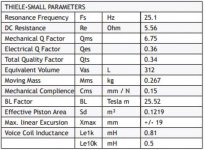
4 Ohm:
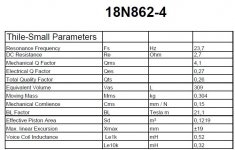
I ordered 8 Ohm versions, but got 4 Ohm.
I did ask BMS to send TS but they haven't replied, so I found the data on thread in here
Didn't think it was going to be a problem until I entered the TS specs in Horn Response and discovered that the 4 Ohm version in fact is very different from the 8 Ohm version.
The TS data suggests a significantly smaller cab(vented) and higher tuning?
Can it really be true? Any one with actual experience?
Enclosed TS data.
8 Ohm:

4 Ohm:

I think you should sim both for your 'box' and see the results, which you did in HR, can you show the HR responses and what design you'r aiming for. Looking at the BMS site TS specs are basically the same for both 4/8 ohm.
I would not use the driver for a horn loaded design, the cone seems pretty light for withstanding horn pressures.
I would not use the driver for a horn loaded design, the cone seems pretty light for withstanding horn pressures.
Last edited:
I think you should sim both for your 'box' and see the results, which you did in HR, can you show the HR responses and what design you'r aiming for. Looking at the BMS site TS specs are basically the same for both 4/8 ohm.
I would not use the driver for a horn loaded design, the cone seems pretty light for withstanding horn pressures.
I am aiming for a ported cab with a Fb in the area of 25-30 hz.
I have enclosed sims from WinISD, - if the data that I found in another thread can be trusted, - there is quite a bit of difference between the sims of the 8 vs 4 Ohms versions, - I've just never come across such a big difference in TS before
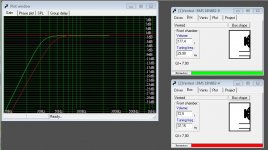
And this is from HR. Comments are very welcome.
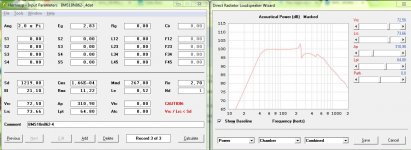
Last edited:
USRFobiwan:
Yes, apparently there is a lot of difference. I have enclosed TS for both 4 and 8 Ohms in post#1. I got them from someone who got them from BMS.
When discussing 4 or 8 Ohm subs I only hear people talk about if it is possible according to amp specifications and applications, - never about TS differences between 4 and 8 Ohms and the consequences that the difference in TS can have on Fb and optimal Vb.
Yes, apparently there is a lot of difference. I have enclosed TS for both 4 and 8 Ohms in post#1. I got them from someone who got them from BMS.
When discussing 4 or 8 Ohm subs I only hear people talk about if it is possible according to amp specifications and applications, - never about TS differences between 4 and 8 Ohms and the consequences that the difference in TS can have on Fb and optimal Vb.
The 4Ohm driver has more copper in the winding, that's all.
Hence higher Mms, lower Fs, higher BL²/Re, etc. Should also have a higher power handling.
Nothing to worry about IMHO. EQ it to target, done. 4R vs. 8R won't be off to much (sim both versions with the *same* cabinet and the change will be rather cosmetic and likely be dominated by other uncertains like box/port losses etc)
Hence higher Mms, lower Fs, higher BL²/Re, etc. Should also have a higher power handling.
Nothing to worry about IMHO. EQ it to target, done. 4R vs. 8R won't be off to much (sim both versions with the *same* cabinet and the change will be rather cosmetic and likely be dominated by other uncertains like box/port losses etc)
Yes, apparently there is a lot of difference.
I don't think that there is any significant difference.
I built a 125L sealed box with the 4ohms version, and when researching, @mattkan from avforums uk has modeled the difference between the 4 and the 8ohms version here.
Accourding to @mattkhan:
"I gave them the same power (different volts given the different impedences), differences look tiny to me. The dark line is the 8ohm. I would say that 2dB here or there will be swamped by the normal variance of the driver themselves from the specs & variations in your implementation. Use the one that suits your planned amplication better in other words."

He is one of the most knowledgeable members in the AV community, so you can trust him
I would not use the driver for a horn loaded design, the cone seems pretty light for withstanding horn pressures.
Hmm, < 100 g would be light for an 18", but these can be squeezed at least 2.4x [2x for TH] based on similar lightweight 15" [high] Vas/CR horn ratios, so these high Mms are overkill except for limiting its breakup modes BW.
GM
Ricci mentions this in the BMS@8ohms test here:I would not use the driver for a horn loaded design, the cone seems pretty light for withstanding horn pressures.
"I worry about the cone of this driver handling high power horn loading though as it is very lightweight and not as robust as many other drivers so I would hesitate to recommend it for high pressure high power cabs with potential uneven pressures acting on the cone"
Interesting! The rest must be heavy way out of proportion to loosely sprung 15"ers then. Still, 2-2.4:1 isn't all that high unless the driver spends a goodly percentage of its time at high excursion. Can't find them sold locally to ~test, so guess better to err on the side of caution if in a high power prosound app unless some type of stiffness isn't added, with the attendant loss of motor strength, lower efficiency [higher Qts].
GM
GM
Thank you all for your inputs.
The drivers are indeed going to be used in PA for both live music and DJ, so 2-3 db more or less counts .
.
It is still strange how the 4R and 8R versions sim so differently - see post 3.
The 4R version is a lot better in terms of utilizing my amps. 2 subs per ch. on a K10 seems perfect with 3Kw per driver.
I have done some testing of the driver in an old reflex enclosure of 143 L. Net. tuned to 30Hz and comparing with my TH-18 tapped horns, outside. Don't mind the SPL, as I am not sure I got the setup calibrated correctly, - but for comparison it's fine.
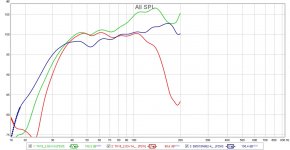
Any suggestions for a Vb and Fb for the BMS 18N862 4R are very welcome.
The drivers are indeed going to be used in PA for both live music and DJ, so 2-3 db more or less counts
It is still strange how the 4R and 8R versions sim so differently - see post 3.
The 4R version is a lot better in terms of utilizing my amps. 2 subs per ch. on a K10 seems perfect with 3Kw per driver.
I have done some testing of the driver in an old reflex enclosure of 143 L. Net. tuned to 30Hz and comparing with my TH-18 tapped horns, outside. Don't mind the SPL, as I am not sure I got the setup calibrated correctly, - but for comparison it's fine.

Any suggestions for a Vb and Fb for the BMS 18N862 4R are very welcome.
The 4Ohm driver has more copper in the winding, that's all.
Hence higher Mms, lower Fs, higher BL²/Re, etc. Should also have a higher power handling.
Nothing to worry about IMHO. EQ it to target, done. 4R vs. 8R won't be off to much (sim both versions with the *same* cabinet and the change will be rather cosmetic and likely be dominated by other uncertains like box/port losses etc)
Actually Mms is higher and Fs lower on the 4R version.. Hmm..?
The AES power rating should be the same, so I would think there is the same amount of cobber? Thread is longer maybe? Thus Re and mH is higher on the 8R version?
Thank you all for your inputs.
It is still strange how the 4R and 8R versions sim so differently - see post 3.
View attachment 616720
Any suggestions for a Vb and Fb for the BMS 18N862 4R are very welcome.
In the sim on post 3 you are comparing 1 driver in a 177L box tuned to 29.9 Hz to the other driver in a 72.5L box tuned to 37.15Hz. Change the box size / tuning of one of them to match the other so that you can compare 'apples to apples'.
Normally, for different Ohms versions of the same driver I would assume that all mechanical parts are identical, down to the VC former. While I'm not familiar with this specific BMS models, I might assume this true here, too.Actually Mms is higher and Fs lower on the 4R version.. Hmm..?
The AES power rating should be the same, so I would think there is the same amount of cobber? Thread is longer maybe? Thus Re and mH is higher on the 8R version?
Given an 8Ohms driver design, to make a 4Ohms version with the same parameters one would need to wind the coil with identical winding height but with a wire that results in 0.71x number of turns and 0.71x the DC resistance per unit length, giving a total of 0.5x DC resistance, still getting otherwise unchanged T/S-parameters (except Re, BL, Le of course) including copper mass.
In contrast, with the BMS copper mass of the 4Ohms seems to be higher (under the aussumption of mechanical identity) and one of it's indicators, (BL)²/Re is also higher. This higher copper mass would perfectly explain the higher Mms, lower Fs, Qes etc.
Last edited:
In the sim on post 3 you are comparing 1 driver in a 177L box tuned to 29.9 Hz to the other driver in a 72.5L box tuned to 37.15Hz. Change the box size / tuning of one of them to match the other so that you can compare 'apples to apples'.
The example was a demonstration of the difference with 'optimal' Vb and Fb for the respective drivers
I have made a new sim with same Vb and Fb. I am loosing 2db @ 50Hz comparing to the 8R version which translates into a lot of amp power.
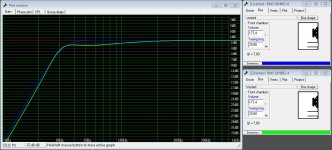
I have been comparing TS data on other 4R and 8R drivers and never seen anyone with that much difference.
Qts is 0.26 vs 0.34 for the 8R?
Mms with 37g more for the 4R?
Bl is still lower for the 4R
Now the 2 plots look a lot closer than in post 3. Try raising the tuning of the 4 ohm box slightly and dropping the box volume a bit and they will be a bit closer , but with a higher f3 on the 4 ohm curve.
I think you'll need to measure the actual drivers if you want your real box to match the sim exactly (none of the drivers I have measured with dats2 have been that close to published specs)
Rob.
I think you'll need to measure the actual drivers if you want your real box to match the sim exactly (none of the drivers I have measured with dats2 have been that close to published specs)
Rob.
I ordered 8 Ohm versions, but got 4 Ohm.
Try to send them back or get a big part of your Money back and sell the 4 Ohm Drivers.
FWIW, the pioneers based cab size on a driver's compliance, so with these being near identical as they should be: [309*312^0.5]/1.44 = ~216.622 L net for either one and tuned to get the max practical peak SPL once all series resistance, thermal power compression is factored in and since the 4 ohm will change more/sooner than the 8 ohm, I'm betting that their power response would be near equal at the same tuning in a prosound app.
GM
GM
FWIW, the pioneers based cab size on a driver's compliance, so with these being near identical as they should be: [309*312^0.5]/1.44 = ~216.622 L net for either one and tuned to get the max practical peak SPL once all series resistance, thermal power compression is factored in and since the 4 ohm will change more/sooner than the 8 ohm, I'm betting that their power response would be near equal at the same tuning in a prosound app.
GM
Thanks GM. Interesting approach. So Qts is not that important after all?
I did actually aim for a 215 L Net cab, not from SIMs but from other manufactors of pro PA subs that reaches the goal of -6db@25Hz like CODA SCP and SB28 fom L'Accoustics.
When comparing other 4 and 8 ohm drivers the difference between Qts is much less than for the BMS. I have enclosed a list comparing with B&C 18SW115:

Last edited:
- Status
- This old topic is closed. If you want to reopen this topic, contact a moderator using the "Report Post" button.
- Home
- Loudspeakers
- Subwoofers
- BMS 18N862 8 or 4 Ohms?